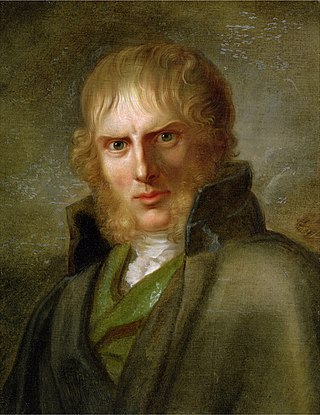
Caspar David Friedrich was a German Romantic landscape painter, generally considered the most important German artist of his generation. He is best known for his allegorical landscapes, which typically feature contemplative figures silhouetted against night skies, morning mists, barren trees or Gothic ruins. His primary interest was the contemplation of nature, and his often symbolic and anti-classical work seeks to convey a subjective, emotional response to the natural world. Friedrich's paintings characteristically set a human presence in diminished perspective amid expansive landscapes, reducing the figures to a scale that, according to the art historian Christopher John Murray, directs "the viewer's gaze towards their metaphysical dimension".

Giovanni di Niccolò de Luteri, better known as Dosso Dossi, was an Italian Renaissance painter who belonged to the School of Ferrara, painting in a style mainly influenced by Venetian painting, in particular Giorgione and early Titian.

Philipp Otto Runge was a German artist, draftsman, painter, and color theorist. Runge and Caspar David Friedrich are often regarded as the leading painters of the German Romantic movement. He is frequently compared with William Blake by art historians, although Runge's short ten-year career is not easy to equate to Blake's career. By all accounts he had a brilliant mind and was well versed in the literature and philosophy of his time. He was a prolific letter writer and maintained correspondences and friendships with contemporaries such as Carl Ludwig Heinrich Berger, Caspar David Friedrich, Johann Wolfgang von Goethe, Friedrich Wilhelm Joseph Schelling, Henrik Steffens, and Ludwig Tieck. His paintings are often laden symbolism and allegories. For eight years he planned and refined his seminal project, Tageszeiten, four monumental paintings 50 square meters each, which in turn were only part of a larger collaborative Gesamtkunstwerk that was to include poetry, music, and architecture, but remained unrealized at the time of his death. With it he aspired to abandon the traditional iconography of Christianity in European art and find a new expression for spiritual values through symbolism in landscapes. One historian stated "In Runge's painting we are clearly dealing with the attempt to present contemporary philosophy in art." He wrote an influential volume on color theory in 1808, Sphere of Colors, that was published the same year he died.

Otto Müller was a German painter and printmaker of the Die Brücke expressionist movement.

The Hamburger Kunsthalle is the art museum of the Free and Hanseatic City of Hamburg, Germany. It is one of the largest art museums in the country. It consists of three connected buildings, dating from 1869, 1921 (Kuppelsaal) and 1997, located in the Altstadt district between the Hauptbahnhof and the two Alster lakes.

The Albertinum is a modern art museum. The sandstone-clad Renaissance Revival building is located on Brühl's Terrace in the historic center of Dresden, Germany. It is named after King Albert of Saxony.

The Kunsthalle Bremen is an art museum in Bremen, Germany. It is located close to the Bremen Old Town on the "Culture Mile". The Kunsthalle was built in 1849, enlarged in 1902 by architect Eduard Gildemeister, and expanded several more times, most notably in 2011. Since 1977, the building has been designated a Kulturdenkmal on Germany's buildings heritage list.

Wanderer above the Sea of Fog is a painting by German Romanticist artist Caspar David Friedrich made in 1818. It depicts a man standing upon a rocky precipice with his back to the viewer; he is gazing out on a landscape covered in a thick sea of fog through which other ridges, trees, and mountains pierce, which stretches out into the distance indefinitely.
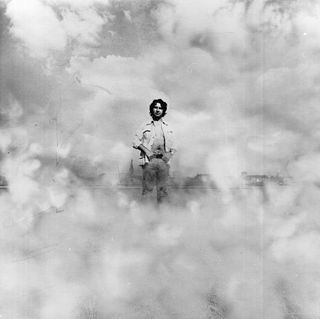
Gotthard Graubner was a German painter, born in Erlbach, in Saxony, Germany.

The Sea of Ice, (1823–1824), is an oil painting that depicts a shipwreck in the Arctic by the German Romantic painter Caspar David Friedrich. Before 1826 this painting was known as The Polar Sea.
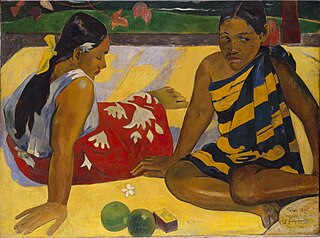
The Galerie Neue Meister in Dresden, Germany, displays around 300 paintings from the 19th century until today, including works from Otto Dix, Edgar Degas, Vincent van Gogh and Claude Monet. The gallery also exhibits a number of sculptures from the Dresden Sculpture Collection from the same period. The museum's collection grew out of the Old Masters Gallery, for which contemporary works were increasingly purchased after 1843.
Martin Eder is a German artist.
Max Uhlig is a German painter. He won the Hans Theo Richter-Preis of the Sächsische Akademie der Künste in 1998.

Theodor Gustav Pauli was a German art historian and museum director in Bremen and Hamburg.
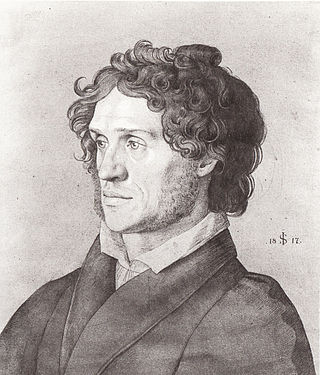
Johann Heinrich Ferdinand Olivier (1785–1841) was a German painter associated with the Nazarene movement.

Cairn in Snow, also known as Dolmen in the snow, is a landscape painting by the German painter Caspar David Friedrich. Friedrich is noted for his landscapes depicting features such as trees or Gothic ruins, silhouetted against the sky or in morning mists. The painting depicts leafless trees in the winter snow, with the tops of two of the trees broken off and the third bent by the prevailing wind, giving the work a haunted, spectral air. It is a Romantic allegorical landscape, depicting a stone cairn or dolmen set amid three oak trees on a hilltop, with a contemplative melancholy mood. It was probably painted around 1807, making it among Friedrich's first oil paintings. It measures 61 by 80 centimetres and has been held by the Galerie Neue Meister in Dresden since 1905.

The Woman with the Spider's Web is a small c. 1803 print by the German Romantic painter Caspar David Friedrich, made into a woodcut the same year by his brother Christian Friedrich, a carpenter and furniture maker.
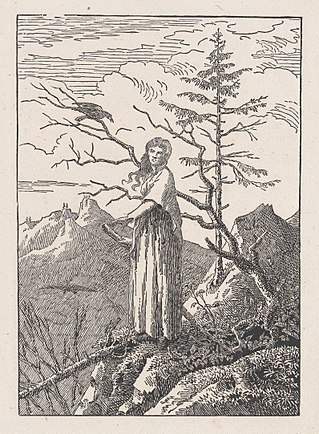
Woman with a Raven at an Abyss is a c. 1803/04 print by the German Romantic painter Caspar David Friedrich, made into a woodcut by his brother Christian Friedrich, a carpenter and furniture maker, around the same time.

Robert Schneider was a German portrait painter who worked in Hamburg and Lübeck. He was one of the first portraitists in that area to move from the earlier Romanticized style to more nearly pictorial representations.





















